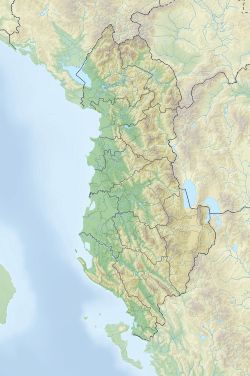Top Qs
Timeline
Chat
Perspective
Church of Saint Nicholas, Lezhë
Ruined former church; former mosque in Lezhë, Albania From Wikipedia, the free encyclopedia
Remove ads
The Church of Saint Nicholas (Albanian: Kisha e Shën Nikollës, Kisha e Shna Kollit), also known as the Selimije Mosque (Albanian: Xhamia e Selimies), the Church-Mosque of Lezhë (Kisha-Xhami), and, since the 1980s, as the Skanderbeg National Memorial, is a former Roman Catholic church and subsequently a former Islamic mosque, and now a mausoleum and monument that contains the remains of Skanderbeg. The structure is located in Lezhë, Albania. Likely to have been established in c. 1st century BCE, the church was repurposed as a mosque after 1478 CE, partially destroyed in c. 1967, and again repurposed as a mausoleum in 1981. The structure is in a partial ruinous state.[1] The site was designated as a Cultural Monument of Albania.[when?]
Remove ads
History
Summarize
Perspective
As a church
Originally built as a church, the stone structure was named after Saint Nicholas. A fresco of the saint is present in the former church apse, although heavily damaged.[2] The church was located in the interior part of an Illyrian city which was later reconstructed by the Romans, in the 1st century BCE. The "Gaviarius" (Gaviarivs) Stone in front of the entrance provides evidence of the building's history, unearthed during archaeological excavations by Frano Prendi and Koço Zheku between 1975 and 1980.
The League of Lezhë was formed in the grounds of the then church in 1444.
As a mosque
When the Ottoman Turks conquered Albania, the church was plundered in 1478 CE,[2][3] and they turned it into a mosque by adding a dikka, a mihrab and a large minaret. The mosque was named after the Ottoman Sultan Selim I. The trouble that Skanderbeg caused to the Ottoman Empire's military forces was such that when the Ottomans found the grave of Skanderbe] in the St. Nicholas they opened it and made amulets of his bones,[2] believing that these would confer bravery on the wearer.[4][dubious – discuss] The St. Nicholas' Church was rebuilt by the Ottomans elsewhere in return as a gesture of tolerance towards Christians.
The Selimiye Mosque was one of the last buildings from the Middle Ages in Lezhë and did not survive during the Communist dictatorship of Enver Hoxha, who destroyed all mosques in Lezhë. The minaret of the Selimie Mosque was torn down.
As a monument
In 1968, for the 500th anniversary of Skanderbeg's death, a memorial was established around the former church.[2] In 1981, the National Memorial opened on the site and contains relics of his battles.[5] Following significant water damage, restoration of the mausoleum commenced in 2018.[3][6]
Remove ads
Gallery
- The original Selimie mosque in 1917
- The "Gaviarivs" engraved stone at the entrance of the castle
See also
References
External links
Wikiwand - on
Seamless Wikipedia browsing. On steroids.
Remove ads





